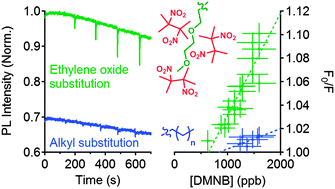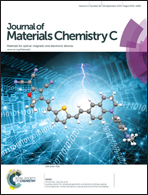Quantitative real time sensing reveals enhanced sensitivity of polar dendrimer thin films for plastic explosive taggants†
Abstract
A method of introducing pulses of analyte vapours has been developed to study the interactions of nitro-containing analytes with fluorescent sensing films. The quenching of the photoluminescence of thin dendrimer films by exposure to sub-saturation concentration vapour pulses of nitro-containing analytes is quantified and the reversibility of quenching interactions qualitatively examined. The analysis reveals a linear dependence of the initial/quenched fluorescence ratio (F0/F) with quencher concentration akin to Stern–Volmer behaviour routinely used to quantify quenching efficiency in solution. Detection limits and quenching efficiencies were calculated in the sub-saturation regime for each of the analytes and trace-level detection of 1,4-dinitrobenzene, 2,4-dinitrotoluene, 4-nitrotoluene, and nitromethane vapours was observed. It was found that the sensitivity of first generation bifluorene- and carbazole-cored dendrimers towards vapours of the nitroaliphatic taggant 2,3-dimethyl-2,3-dinitrobutane was significantly enhanced by changing the solubilising chains on the core from alkyl to oligo(ethylene oxide) groups. The responses of the films were observed to be independent of film exposure history making these dendrimers interesting candidates for deployment in thin film vapour sensors for explosives.


 Please wait while we load your content...
Please wait while we load your content...